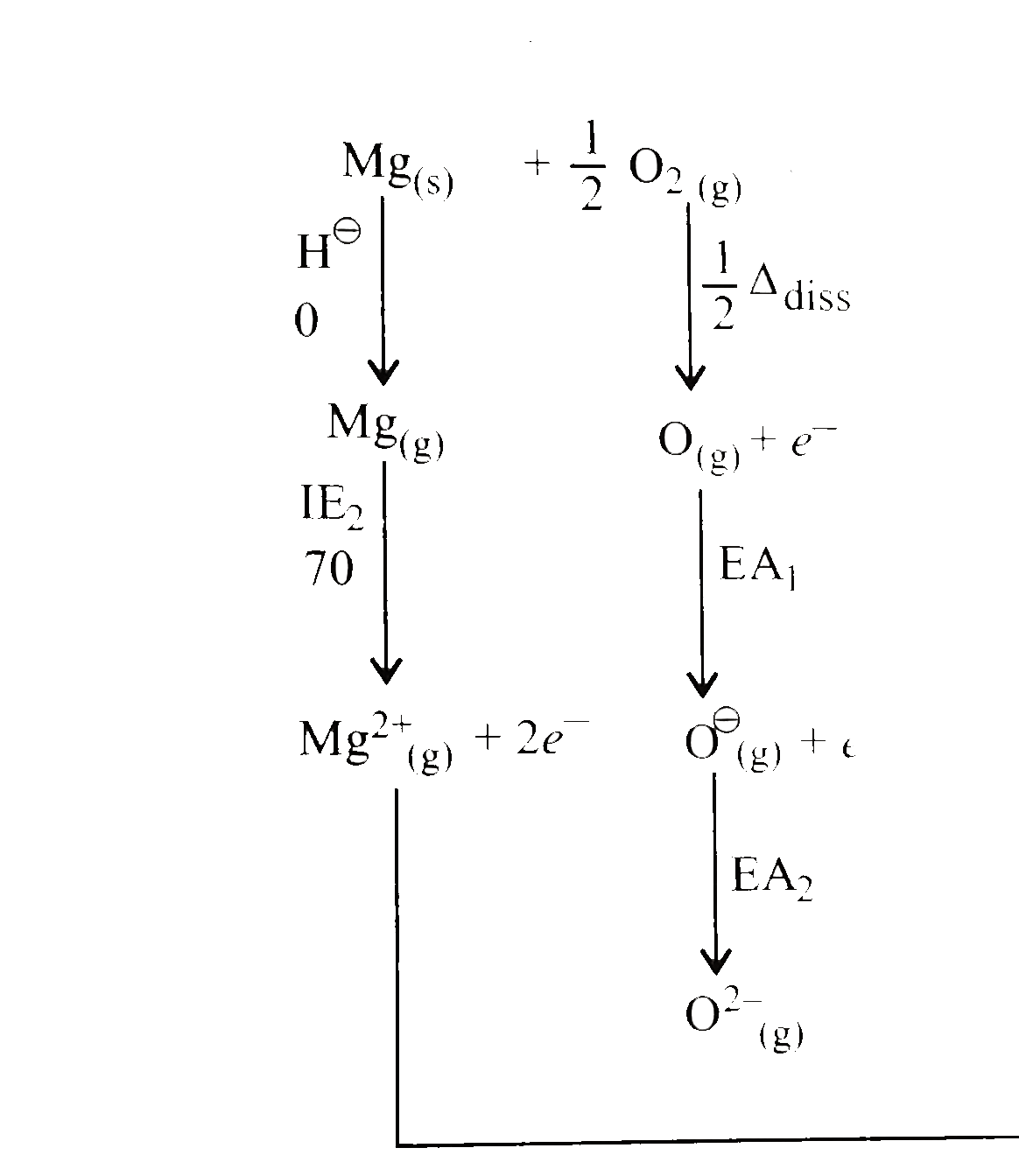Calculate the EA of O atom to O2− ion from the following data:
i. ΔfHɵ[MgO(s)]=−600kJmol−1
ii. ΔuHɵ[MgO(s)]=−3860kJmol−1
iii. IE1+IE2 of Mg(g)=2170kJmol−1
iv. ΔdissHɵ of Mg(s)=+494kJmol−1
v. ΔsubHɵ of Mg(s)=+150kJmol−1
+693kJmol−1
−693kJmol−1
+69.3kJmol−1
−69.3kJmol−1
The correct Answer is:A
Using Born-Haber cycle for MgO, calculation of EA of O atom to O2− ion (All values in kJmol−1)

∴ΔfHɵ=ΔsubHɵ+(IE1+IE2)+12Δdiss+(EA1+EA2)+ΔUHɵ
−600=150+2170+12×494+(EA1+EA2)−3860
∴(EA1+EA2)=+693kJmol−1
Topper's Solved these Questions
- PERIODIC CLASSIFICATION OF ELEMENTS AND GENERAL INORGANIC CHEMISTRYBOOK - CENGAGE CHEMISTRYCHAPTER - PERIODIC CLASSIFICATION OF ELEMENTS AND GENERAL INORGANIC CHEMISTRYEXERCISE - Exercises (Single Correct)Miscellaneous
10 Videos
- PERIODIC CLASSIFICATION OF ELEMENTS AND GENERAL INORGANIC CHEMISTRYBOOK - CENGAGE CHEMISTRYCHAPTER - PERIODIC CLASSIFICATION OF ELEMENTS AND GENERAL INORGANIC CHEMISTRYEXERCISE - Exercises (Assertion Reasoning)
11 Videos
- PERIODIC CLASSIFICATION OF ELEMENTS AND GENERAL INORGANIC CHEMISTRYBOOK - CENGAGE CHEMISTRYCHAPTER - PERIODIC CLASSIFICATION OF ELEMENTS AND GENERAL INORGANIC CHEMISTRYEXERCISE - Exercises (Single Correct) Bond Angle
4 Videos
- P-BLOCK GROUP 14 - CARBON FAMILYBOOK - CENGAGE CHEMISTRYCHAPTER - P-BLOCK GROUP 14 - CARBON FAMILYEXERCISE - Exercises Archives (Subjective)
9 Videos
- PURIFICATION OF ORGANIC COMPOUNDS AND QUALITATIVE AND QUANTITATIVE ANALYSISBOOK - CENGAGE CHEMISTRYCHAPTER - PURIFICATION OF ORGANIC COMPOUNDS AND QUALITATIVE AND QUANTITATIVE ANALYSISEXERCISE - Assertion Reasoning Type
5 Videos
Similar Questions
Find ΔH of the process
NaOH(s)→NaOH(g)
Given: ΔdissHΘofO2=151kJmol−1
ΔdissHΘofH2=435kJmol−1
ΔdissHΘofO−H=465kJmol−1
ΔdissHΘofNa−O=255kJmol−1
ΔsolnHΘofNaOH=−46kJmol−1
ΔfHΘofNaOH(s)=−427kJmol−1
ΔsubHΘofNa(s)=109kJmol−1
View SolutionCalculate the resonance energy of gaseous benzene form the following data.
BE(C−H)=416.3kJmol−1
BE(C−C)=331.4kJmol−1
BE(C=C)=591.1kJmol−1
ΔsubHΘ(C,graphite)=718.4kJmol−1
ΔdissHΘ(H2,g)=435.9kJmol−1
ΔfHΘ(benzene,g)=82.9kJmol−1
View Solution
Knowledge Check
Calculate the lattice energy from the following data (given 1eV=23.0kcalmol−1)
i. ΔfHɵ(KI)=−78.0kcalmol−1
ii. IE1 of K=4.0eV
iii. ΔdissHɵ(I2)=28.0kcalmol−1
iv. ΔsubHɵ(K)=20.0kcalmol−1 ltbvrgt v. EA of I=−70.0kcalmol−1
vi. ΔsubHɵ of I2=14.0kcalmol−1A+14.1kcalmol−1B−14.1kcalmol−1C−141kcalmol−1D+141kcalmol−1If ΔfH∘_(C3H8(g))=−85kJmoll−1,
ΔfH∘_(C3H8(g))=−104kJmol−1,
ΔH for C(s)→C(g) is 718kJmol−1 and heat of formation of H− atom is 218kJmol−1, then :AeC−H=414kJBeC−C=345kJCeH−H=218kJDeH−H=436kJ
Calculate the lattice energy of the reaction
Li⊕(g)+CIΘ(g)→LiCI(s)
from the following data:
ΔsubHΘ(Li)=160.67kJmol−1,12D(CI2)=122.17kJmol−1IP(Li)=520.07kJmol−1,EA(CI)=−365.26kJmol−1 and ΔfHΘ(LiCI)=−401.66kJmol−1
View SolutionCalculate the standard N- H bond enthalpy from the following data :
N2(g)+2H2(g)→2NH3(g)ΔH∘=−83kJ
ΔH∘(N=N)=946kJmol−1,ΔH∘(H−H)436kJmol−1
View SolutionCalculate ΔfH∘ for chloride ion from the following data:
12H2(g)+12CI2(g)→HCI(g)
ΔfH∘=−92.8kJmol−1
HCI(g)+H2O→H3O+(aq)+CI−(aq)
ΔdissH∘=−75.2kJmol−1.
View SolutionFind the enthalpy of S – S bond from the data.
S (g) = ΔH∘f=222.8 kJ /mol
View SolutionCalculate the temperature at which liquid water will be in equilibrium with water vapour.
ΔvapH=40.00kJmol−1 and ΔvapS=0.100kJmol−1K−1
View SolutionCalculate the enthalpy of combustion of benzene (l) on the basis of the following data:
a. Resonance energy of benzene (l)=−152kJ/mol
b. Enthalpy of hydrogenation of cyclohexene (l)=−119kJ/mol
c. ΔfHΘC6H12(l)=−156kJmol−1
d. ΔfHΘofH2O(l)=−285.8kJmol−1
e. ΔfHΘofCO2(g)=−393.5kJmol−1
View Solution
